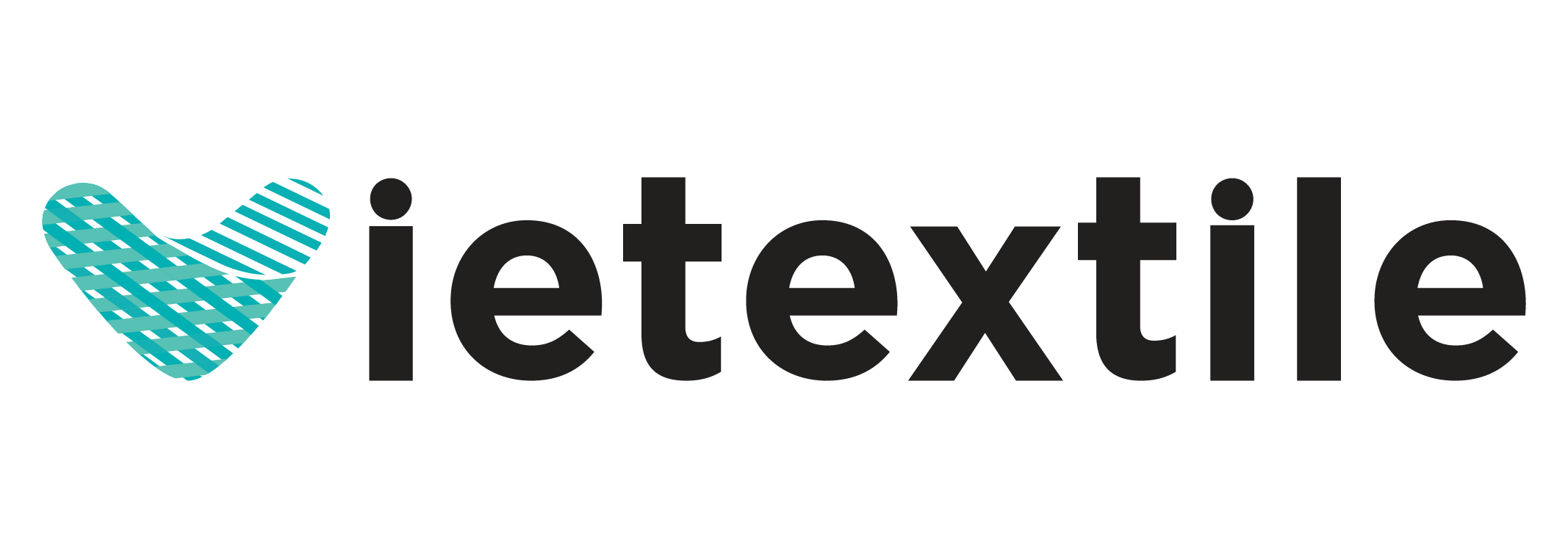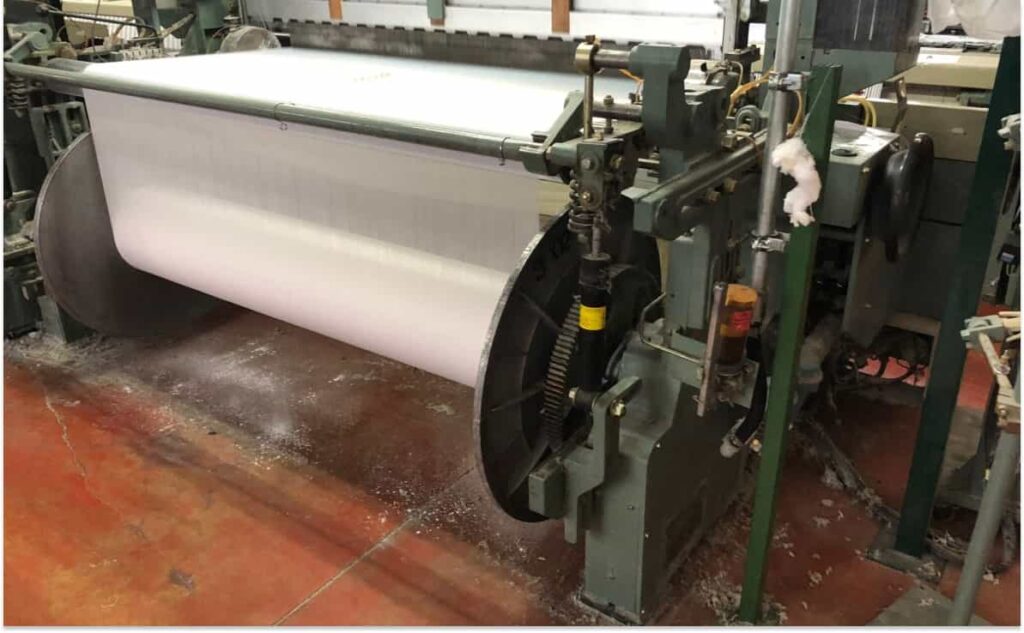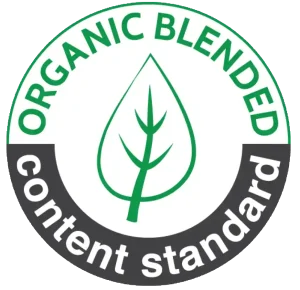In the textile world, the Dornier Rapier loom represents the pinnacle of flexibility, precision, and delicate yarn handling capability. Unlike high-speed models specializing in weaving commodity fabrics such as Airjet or Waterjet, Dornier Rapier is specifically engineered to conquer the challenges of Technical Textiles – where durability, structural accuracy, and the ability to handle expensive, sensitive yarns (such as Carbon, Aramid, Glass fiber) are paramount.
This advantage stems not just from the brand, but from the perfect synchronization among exclusive Dornier Rapier Loom Components, particularly the Positive Gripper Weft Insertion Mechanism. This article will delve into every technical aspect, from the mechanical structure to the electronic control system, to decipher why Dornier Rapier is the leading choice for technical fabric manufacturers globally.
Technical weaving is the most demanding market segment, producing fabrics used in aerospace, automotive, medical, and construction industries. The yarns used in this sector are often very thick, rigid, or extremely brittle and sensitive to friction, requiring a weft insertion mechanism that is exceptionally gentle yet ensures the tension and accuracy of every pick.
Dornier Rapier perfectly meets this requirement thanks to its technological philosophy: “Quality first, Speed second.” The Dornier Rapier Loom Components are not only manufactured from the most advanced materials but are also designed to eliminate mechanical weak points. The Positive Gripper Weft Insertion System, combined with a rigid machine frame and modern electronic control technology, allows the Dornier loom to handle the widest material spectrum on the market, from superfine 10 denier filaments to extremely coarse 10,000 tex yarns.
To truly understand Dornier’s power, we need to analyze eight core technical aspects, highlighting the critical importance of using genuine Dornier Rapier Loom Components to maintain high-tech weaving performance.
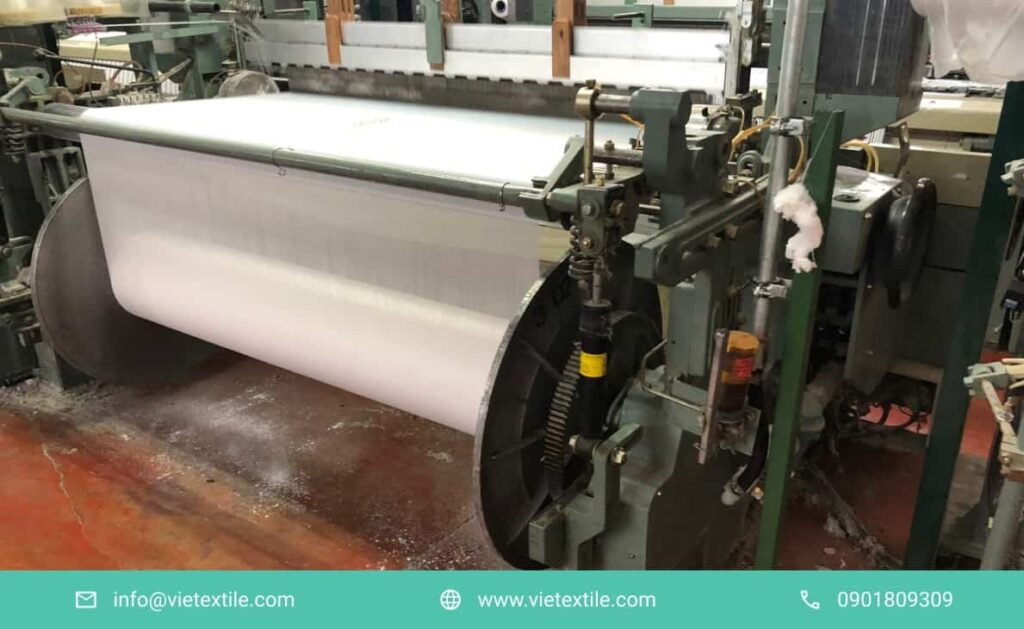
1. Core Mechanical Advantage: The Positive Rapier Weft Insertion System
Nội dung tóm tắt
ToggleThe biggest difference in Dornier lies in its Rapier Weft Insertion Mechanism, especially the Positive Gripper technology, which creates outstanding flexibility and precision.
1.1. Positive Gripper Principle and Sensitive Yarn Weaving
The Positive Gripper mechanism ensures the weft yarn is firmly and gently clamped and exchanged between the two rapier heads (feeder and receiver).
- Gentle Handling: The weft yarn is held at an absolutely low and stable tension throughout the insertion process. This is crucial when weaving Glass Fiber or Carbon fiber, which are highly susceptible to damage, breakage, or surface wear due to high friction.
- Gripper Head: The Gripper Head, a critical Dornier Rapier Loom Component, is made of special material with an optimally designed contact surface to minimize friction force when clamping the yarn.
- Self-Cleaning Capability: The clamping mechanism is designed to automatically remove fragmented yarn pieces, preventing accumulation and avoiding clamping errors.
1.2. Analysis of the Rapier Tape/Band Structure
The Rapier Tape is the fastest moving and highest loaded part of the weft insertion system.
- Advanced Material: Dornier OEM uses composite material or reinforced carbon fiber for the Rapier Tape. This material helps reduce the inertia mass of the mechanism, allowing the loom to achieve higher speeds and reduce vibration.
- Impact on Speed: Lighter Rapier Tapes reduce the load on the main drive system and lower energy consumption. Using non-genuine Dornier Rapier Loom Components made of inferior material (like heavier steel alloys) will significantly reduce weaving speed and increase wear on related gears.
- Durability and Precision: The OEM Rapier Tape has absolute stiffness and dimensional stability, ensuring the gripper head is always positioned accurately, even when weaving wide widths (540 cm).
2. Wide Material Spectrum and Diverse Applications
Dornier Rapier is favored for its ability to handle the widest material spectrum, from the finest to the coarsest.
2.1. Weaving Coarse and Special Yarns
For technical fabrics, the yarn is often multifilament with very high fineness (for filter meshes) or coarse, rigid yarn (for Geotextiles).
- Aramid/Kevlar & Carbon: These yarns have extremely high tensile strength but are brittle and expensive. Unstable tension created by the Airjet mechanism can cause yarn breakage. Dornier Rapier, with its Positive Insertion Mechanism, maintains near-zero yarn tension during insertion, preserving yarn integrity.
- Weaving Widths up to 540 cm: The Dornier loom is one of the few Rapier models that can weave wide widths stably. This is extremely important for industrial products such as Geomembranes or large industrial filter meshes.
2.2. Weaving Multi-Layer Fabrics (3D/Multi-Layer)
Weaving three-dimensional structures or multi-layer fabrics (e.g., spacer fabrics) is an exclusive strength of Dornier Rapier.
- Requirement: Absolute precision is needed in shedding and uniform weft insertion force across the entire width.
- Role of Dornier Rapier Loom Components: The stability of the Monolithic Frame Rigidity and the Dornier Rapier drive system helps maintain perfect Sley and Reed alignment, allowing complex structures to be woven without distortion.
3. Exclusive Machine Frame and Vibration Reduction System
High-tech weaving accuracy demands an extremely stable mechanical platform.
3.1. Monolithic Frame Rigidity
The Dornier frame is designed as a heavy, extremely rigid monolithic structure, absorbing most of the vibration generated during high-speed weaving.
- Benefit: This rigidity ensures that all moving mechanisms (Shedding, Tappet, Weft Insertion) maintain precise alignment even when operating at high speeds or weaving heavy, coarse yarns.
- Quality Assurance: Reduced vibration directly lowers the rate of warp and weft yarn breakage, especially when weaving brittle yarns.
3.2. Mass Balancing System
Dornier utilizes counterweights and advanced drive designs to automatically balance the inertia mass of the moving Rapier mechanism.
- Quality of Dornier Rapier Loom Components in Drive: Gears and main shafts are manufactured with P5 precision or higher, minimizing friction and wear. This increases the lifespan of expensive mechanical parts.
- Energy Efficiency: Reducing unnecessary vibration also helps lower energy consumption and noise, creating a better working environment.
4. PCL (Programming Control Logic) and Electronics Technology
The flexibility in Dornier Rapier applications is supported by its exclusive PCL electronic control system.
4.1. PICANOL-DORNIER Control Logic
Dornier’s electronic control system allows flexible adjustment of nearly every weaving parameter, from warp tension and brake force to Weft Timing. The management of electronic Dornier Rapier Loom Components is essential for this precision.
- Application Flexibility: Engineers can quickly change these parameters via the HMI screen, allowing for efficient Quick Style Change (QSC), which is crucial for small, diverse orders in technical weaving.
- Electronic Dornier Rapier Loom Components: Dornier’s Sensors and Encoders are OEM, ensuring high resolution and instantaneous response speed, necessary for precise Rapier positioning control.
4.2. Advanced Stop Motion System (Warp/Weft Stop Motion)
The sensitivity of the stop motion system is a key factor in protecting expensive yarns.
- Weft Stop Motion (Weft Breakage Stop): Dornier Rapier uses highly sensitive optical or piezoelectric sensors, ensuring the loom stops immediately upon detecting yarn breakage. The reaction speed must be less than 1 ms to prevent extended weaving defects.
- Critical Dornier Rapier Loom Components PCB: The Main Control PCB is specifically designed to handle high-speed signals and activate a powerful electromagnetic brake. Replacing this board with an Aftermarket item, especially if it is not a genuine Dornier Rapier Loom Component, can significantly reduce the reaction speed, leading to severe errors when weaving expensive Carbon fiber.
5. Maintenance Strategy and Management of Dornier Rapier Loom Components
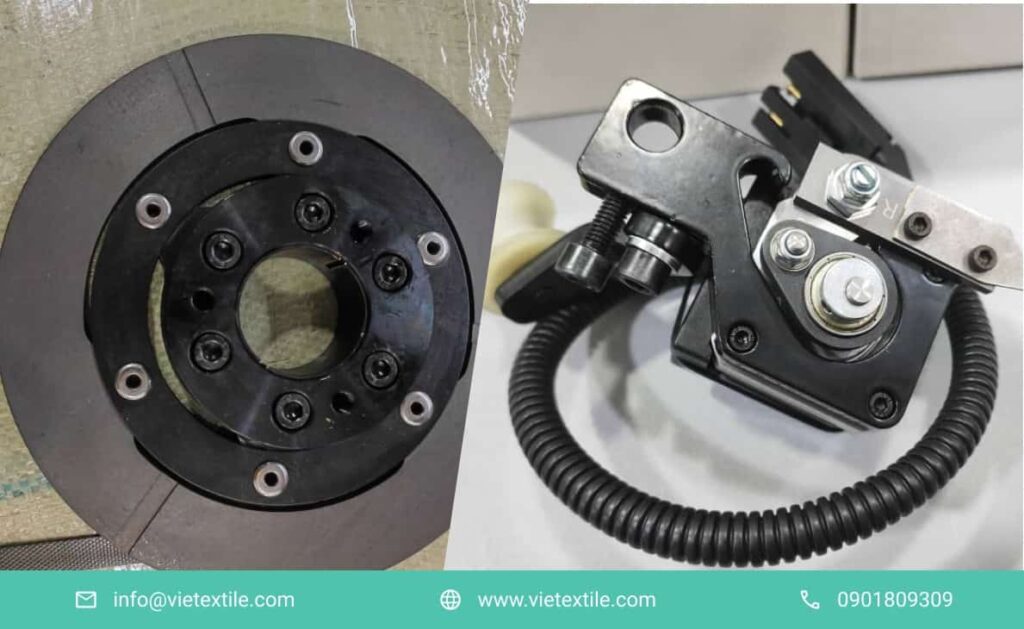
For the Dornier Rapier to operate optimally in high-tech weaving, managing replacement Dornier Rapier Loom Components is mandatory.
5.1. Prioritizing OEM Components for the Rapier Mechanism
The Rapier Assembly is the most critical and expensive component.
- Rapier Tape: Although the purchase price of OEM Dornier Rapier Loom Components is high, the lifespan and stability of the OEM Rapier Tape are many times greater than Aftermarket items. Using poor-quality Rapier Tapes can lead to premature wear of Guide Hooks and damage to other Dornier Rapier Loom Components.
- Gripper Head: Must be replaced cyclically. The OEM Gripper Head ensures accurate clamping angle, stiffness, and precise anti-wear material, protecting the woven yarn from damage.
5.2. Centralized Lubrication System Maintenance
The Dornier Rapier lubrication system is automatic and centralized (Centralized Lubrication System).
- Lubrication Dornier Rapier Loom Components: The oil pump, oil distribution valves, and pipelines – these critical Dornier Rapier Loom Components must be OEM to ensure precise oil pressure at every important lubrication point (main shaft, gearbox).
- Importance: Clogging or insufficient oil pressure can cause serious and costly damage to gears and drive shafts.
5.3. Tolerance Control of Mechanical Spare Parts
In high-tech weaving, the tolerance of Dornier Rapier Loom Components must be absolutely guaranteed.
- Reed: The OEM Reed has extremely high flatness and accuracy in the distance between the dents, ensuring uniform warp yarn distribution. Aftermarket Dornier Rapier Loom Components may have small errors, causing Barre defects on the fabric.
- Gear Mesh Position: The gears in the gearbox must mesh perfectly. OEM ensures no backlash, allowing for smooth and precise power transmission.
6. In-Depth Technical Analysis of Specific Dornier Rapier Loom Components
To achieve a deeper understanding, we need to detail the mechanical and electronic parts.
6.1. Electronic Take-Up & Let-Off Mechanism
Dornier looms use a Take-Up (cloth winding) and Let-Off (warp yarn release) system fully controlled by electronic Servo Motors.
- OEM Servo Motor: A core electronic Dornier Rapier Loom Component, ensures continuous maintenance of Warp Tension, even when machine speed changes. This is important when weaving stretchy fabrics or fabrics with different thicknesses.
- Tension Sensor: The warp tension sensor must have high resolution to send precise feedback signals to the PCL controller, ensuring effective closed-loop control operation.
6.2. Shedding Motion Control
Dornier prioritizes the use of electronic Dobby or Jacquard for high-tech weaving.
- Electronic Dobby/Jacquard: Independently controlled, allowing for the creation of complex and precise sheds (e.g., 3/1 Twill, Satin, or 3D structures).
- Lifting/Lowering Mechanism Dornier Rapier Loom Components: The Push Rods and Draw Hooks in the Dobby must be OEM, capable of high load endurance and long lifespan. Minor flaws in these Dornier Rapier Loom Components can cause Warp Streaks defects on the fabric.
6.3. Infinitely Variable Shed Angle Control Capability
New generation Dornier Rapier looms allow for infinitely variable adjustment of the Shed Angle via Servo Motor.
- Benefit: Optimizes the shed for different yarn types. Coarse yarns need a wider shed, while brittle yarns need a gentle, narrow shed.
- Main Encoder: The Main Encoder is a critical Dornier Rapier Loom Component, providing main shaft position data with high resolution, allowing the PCL controller to change the shed angle and Weft Insertion Timing for each weaving cycle.
7. Impact on Total Cost of Ownership (TCO) and Profitability

The high initial cost of the Dornier Rapier loom and Dornier Rapier Loom Components is offset by lower TCO and superior output quality.
7.1. Reduced Damage Cost from Expensive Yarns (Material Damage Cost)
When weaving Carbon or Aramid fibers (priced at 10 – 50 USD/kg), the cost of damage due to yarn breakage is substantial.
- Dornier Rapier: Due to the Positive Insertion Mechanism, the yarn breakage rate is significantly lower than Airjet/Waterjet when weaving these materials.
- Spare Parts TCO: Investing in OEM Dornier Rapier Loom Components protects expensive yarns from damage, leading to much higher Net Profit.
7.2. Energy Optimization in Technical Weaving
Although Rapier looms consume more energy than Airjet (due to the mechanical energy required to move the Rapier), Dornier Rapier has an optimized drive design.
- Efficient Lubrication System: Reduces friction.
- Lightweight Components: Carbon Rapier Tapes and Composite parts help reduce the load on the motor, saving energy compared to older Rapier models.
8. VieTextile: Strategic Partner for Genuine Dornier Rapier Loom Components
To maintain the technical advantage of the Dornier Rapier, the use of genuine Dornier Rapier Loom Components is mandatory. VieTextile is committed to providing high-quality OEM components and professional technical services.
8.1. Supplying High-Load Components
We provide a full range of Dornier Rapier Loom Components, including:
- OEM Carbon/Composite Rapier Tapes and precision Gripper Heads.
- Control PCBs, Sensors, Encoders ensuring the response speed of the PCL system.
- High-precision tolerance drive components (gears, Sley shaft) for wide-width looms.
8.2. Specialized Alignment and Maintenance Services
Replacing critical Dornier Rapier Loom Components like Rapier Tapes requires precise alignment techniques. VieTextile’s technical team is expertly trained to:
- Align Weft Timing after Rapier replacement.
- Inspect and adjust centralized lubrication pressure, ensuring the lifespan of every mechanical Dornier Rapier Loom Component.
9. Frequently Asked Questions about Dornier Rapier Loom Components (FAQ)
This section addresses specialized questions related to the Dornier Rapier and replacement components.
9.1. Which Dornier Rapier Loom Components are most susceptible to wear? Answer: The Dornier Rapier Loom Components subjected to high friction and load: Rapier Band, Gripper Head, and Guide Hooks. For the electrical system, Weft Stop Motion sensors and Encoders can be damaged due to vibration or fiber fly accumulation.
9.2. Can Aftermarket Dornier Rapier Loom Components be used? Answer: It is not recommended, especially for Grade A components (Rapier Tape, Gripper Head, Control Board). Aftermarket items may have inaccurate tolerances, causing premature wear of related parts and damaging expensive woven yarn, leading to a much higher TCO than investing in genuine Dornier Rapier Loom Components.
9.3. Why is Dornier Rapier more suitable for weaving glass fiber than Airjet? Answer: Glass fiber is very brittle and sensitive to tension. Airjet uses pneumatic force to propel the yarn, creating uneven tension and high friction at the nozzle, easily damaging the fiber. Dornier Rapier uses the Positive Gripper mechanism, inserting the yarn with absolute low and stable tension, preserving the fiber structure.
9.4. How to check the lifespan of a Dornier Rapier Tape? Answer: The lifespan of an OEM Dornier Rapier Tape, one of the Dornier Rapier Loom Components with the most critical lifecycle, is usually measured in operating hours or million picks. Regular checks include: checking the wear of the Rapier surface (friction level), inspecting for small cracks on the Composite material, and checking the precise fit of the Gripper Head mounting holes.
9.5. How does VieTextile guarantee the quality of Dornier Rapier Loom Components? Answer: VieTextile only supplies OEM Dornier Rapier Loom Components or replacement parts with OEM-equivalent certification from Dornier-approved European manufacturers. We provide quality certificates and commit to technical alignment support after replacement.
Dornier Rapier is the machine that generates high value in the technical textile industry. Maintaining this advantage requires an absolute commitment to the quality of every replacement component.
To ensure your Dornier loom always operates with the highest performance, precision, and durability, choose genuine Dornier Rapier Loom Components. Contact VieTextile immediately for specialized consultation on spare parts, preventive maintenance, and solutions for optimizing Dornier Rapier performance.
Contact Information:
Hotline: 0901 809 309
Email: info@vietextile.com
Website: https://vietextile.com
